Finite Element Analysis of Combined Energy Piles with Long and Short Heat Exchanger Tubes
Abstract
:1. Introduction
2. Technical Introduction
3. Model Overview
3.1. Basic Assumptions
- (1)
- The operation of energy piles is a complex 3D unsteady state transmission, regardless of the influence of surface temperature changes on the temperature of the soil and pile body. The influence of liquid flow in the heating tube on the temperature distribution as well as the influence of temperature changes on the mechanical properties of the contact interface is not considered.
- (2)
- Precast piles, cement soil, heat exchanger tubes, and soil are homogeneous, their thermophysical properties and mechanical parameters do not change with temperature changes during operation, and heat is transferred between each part by heat conduction.
- (3)
- The initial temperature of the soil and pile body is consistent, and the heat exchanger tubes act as a stable heat source to transfer heat to the surroundings.
- (4)
- Groundwater-bearing soil layers are filled with groundwater, and the speed of the water flow does not change during the flow, regardless of its change along the direction of depth.
- (5)
- The pile body and cement soil are always in the elastic deformation range during the loading process, the friction coefficient between cement soil and soil remains unchanged, and the soil around the pile is elastoplastically deformed.
3.2. Model Building
3.3. Simulation Scenario
- (1)
- To understand the influence of groundwater seepage rate on the deep and shallow combined buried pipe energy pile, test groundwater inflow velocities were set at the inlet and outlet through boundary conditions at the load interface: 0, 2 × 10−6 m/s, 2 × 10−5 m/s and 2 × 10−4 m/s.
- (2)
- To understand the changes in the pile body under summer and winter conditions, the temperature of the heat exchanger tubes in the summer condition is set to 50 pile, test groundwater inflow velocities were 5 °C [10].
- (3)
- It is found that the longer the length of the energy pile, the better the heat transfer performance [22,24], but the effect of the length of the heat exchanger tubes on the inside of the pile on the pile body is unknown. Therefore, the length of the heat exchanger tubes on the inner side of the pile is 0 m, 40 m, 60 m, and 80 m, respectively.
4. Analysis of the Results
4.1. Pile Information
4.2. Temperature of the Pile Body and the Cement Soil Inside the Pile
4.3. Pile Top Displacement
4.4. Pile Axial Force
4.5. Pile Side Friction Resistance
5. Conclusions and Prospect
- (1)
- The new energy pile technology considers the groundwater condition., which enhances the heat exchange between the tubes and the soil. It also helps to dissipate the heat from the soil, effectively addressing the issue of heat accumulation.
- (2)
- The temperature change of the cement soil in the pile is consistently higher than the temperature of the pile body by 1–2 °C. As the length of the heat exchanger tubes on the inside of the pile increases, the stable temperature change of both the pile body and the cement soil gradually decreases.
- (3)
- When there is groundwater flow, the temperature change of the pile gradually decreases with the acceleration of groundwater flow. The maximum temperature change can be reduced by 11.91% (1.69 °C) and 8.82% (0.83 °C) for cooling changes. Additionally, the pile body reaches a stable temperature become faster under groundwater flow condition; and the higher the flow rate is, the faster the stabilization will be reached.
- (4)
- Under the coupling effect of heat and force, the displacement is positively correlated with the temperature change. Although the arrangement of heat exchange tubes inside the pile increases the amount of heat exchange, the maximum changes in the uplift and settlement of the pile top only increase by 0.66 mm and 0.41 mm, respectively.
- (5)
- Under the action of thermal coupling, the expansion of the pile shaft results in a decrease in the lateral friction resistance of the upper section and an increase in the axial force of the lower section. The axial force change of the pile shaft is positively correlated with temperature change. The axial force change increases for the new energy pile, but the maximum change is only 61 kN and −19 kN for temperature heating or cooling condition, respectively.
- (6)
- Compared with L2 = 80 m, v = 2 × 10−4 m/s and L2 = 0 m, v = 2 × 10−4 m/s, the temperature difference of the average temperature of the pile body is within 1 °C; hence, after the heat exchanger tubes on the inside of the pile are laid, the axial force of the pile body and the displacement of the top of the pile are not obvious. The average temperature of the heat exchanger tubes on the outside of the pile and the outlet of the heat exchanger tubes on the inside of the pile are 45.50 °C and 34.22 °C, respectively, and the total heat exchange increases by a factor of 1.75.
- (7)
- This paper focuses on the effect of different tube types on heat exchange efficiency and the mechanical properties of pile and soil layers. The design of heat exchanger needs to consider many factors, such as building environment, energy demand, geological conditions, structural design, etc., which is worthy of further study. In addition, comparative studies that include theoretical analyses, numerical simulations, and field measurements are needed to further promote the application of the new energy pile technology.
Author Contributions
Funding
Institutional Review Board Statement
Informed Consent Statement
Data Availability Statement
Acknowledgments
Conflicts of Interest
References
- Chen, Y.; Chen, Y. The theoretical implication and significance of Xi Jinping’s important discourse on tackling global climate change. Marx. Real. 2021, 6, 1–25+195. [Google Scholar]
- Go, G.-H.; Lee, S.-R.; Kang, H.-B.; Yoon, S.; Kim, M.-J. A novel hybrid design algorithm for spiral coil energy piles that considers groundwater advection. Appl. Therm. Eng. 2015, 78, 196–208. [Google Scholar] [CrossRef]
- Yang, W.; Qiang, Y.; Ju, L.; Wang, F.; Liu, A. Numerical evaluations on the effects of different factors on thermo- mechanical behaviour of an energy pile group. Comput. Geotech. 2023, 162, 105664. [Google Scholar] [CrossRef]
- Barbieri, S.; Antelmi, M.; Panday, S.; Baratto, M.; Angelotti, A.; Alberti, L. Innovative numerical procedure for simulating borehole heat exchangers operation and interpreting thermal response test through MODFLOW-USG code. J. Hydrol. 2022, 614, 128556. [Google Scholar] [CrossRef]
- Antelmi, M.; Turrin, F.; Zille, A.; Fedrizzi, R. A New Type in TRNSYS 18 for Simulation of Borehole Heat Exchangers Affected by Different Groundwater Flow Velocities. Energies 2023, 16, 1288. [Google Scholar] [CrossRef]
- Brandl, H. Energy foundations and other thermo-active ground structures. Géotechnique 2006, 56, 81–122. [Google Scholar] [CrossRef]
- Morino, K.; Oka, T. Study on heat exchanged in soil by circulating water in a steel pile. Energy Build. 1994, 21, 65–78. [Google Scholar] [CrossRef]
- Sung, C.; Park, S.; Lee, S.; Oh, K.; Choi, H. Thermo-mechanical behavior of cast-in-place energy piles. Energy 2018, 161, 920–938. [Google Scholar] [CrossRef]
- Park, S.; Lee, S.; Oh, K.; Kim, D.; Choi, H. Engineering chart for thermal performance of cast-in-place energy pile considering thermal resistance. Appl. Therm. Eng. 2018, 130, 899–921. [Google Scholar] [CrossRef]
- Li, F.Y.; Wang, Z.J.; Xie, X.Y.; Lou, Y.; Wang, K.H.; Fang, P.F.; Zheng, L.W. Model test on bearing characteristic of static drill rooted energy pile. Rock Soil Mech. 2020, 41, 3307–3316. [Google Scholar]
- Cao, G.; Deng, Y.; Yu, L.; Zhang, R. Model test of static drilling and rooted energy pileconsidering over-consolidated behavior of soft soil. J. Shenzhen Univ. (Sci. Technol. Ed.) 2022, 39, 93–100. [Google Scholar]
- Yoon, Y.; Hyeon, S.; Kim, D.R.; Lee, K.S. Minimizing thermal interference effects of multiple heat sources for effective cooling of power conversion electronics. Energy Convers. Manag. 2018, 174, 218–226. [Google Scholar] [CrossRef]
- Park, S.; Lee, S.; Lee, D.; Ahn, D.; Choi, H. Effect of thermal interference on energy piles considering various configurations of heat exchangers. Energy Build. 2019, 199, 381–401. [Google Scholar] [CrossRef]
- Suryatriyastuti, M.; Mroueh, H.; Burlon, S. A load transfer approach for studying the cyclic behavior of thermo-active piles. Comput. Geotech. 2014, 55, 378–391. [Google Scholar] [CrossRef]
- Lyu, W.; Pu, H.; Xiao, H.; Hu, D.; Ma, Q. Thermal performance of energy pile with deeply penetrating 1-U-shape heat exchanger. Geothermics 2021, 91, 102023. [Google Scholar] [CrossRef]
- Chen, Z.; Hei, D.; Zhang, G.; Xiao, H.; Wang, B. Experiment and simulation research on heat exchange of different types of underground heat exchangers. J. Shenzhen Univ. (Sci. Technol. Ed.) 2022, 39, 20–27. [Google Scholar] [CrossRef]
- Chen, Z.; Yao, J.; Pan, P.; Xiao, H.; Ma, Q. Research on the heat exchange characteristics of the deeply buried pipe type of energy pile. Case Stud. Therm. Eng. 2021, 27, 101268. [Google Scholar] [CrossRef]
- Wang, Z.J.; Fang, P.F.; Wang, K.H.; Zhang, R.H.; Li, F.Y. Interactions between energy piles caused by temperature. Geotech. Res. 2019, 6, 218–226. [Google Scholar] [CrossRef]
- Zhao, H.; Ma, L. Several rough set models in quotient space. CAAI Trans. Intell. Technol. 2022, 7, 69–80. [Google Scholar] [CrossRef]
- Jeong, S.; Lim, H.; Lee, J.K.; Kim, J. Thermally induced mechanical response of energy piles in axially loaded pile groups. Appl. Therm. Eng. 2014, 71, 608–615. [Google Scholar] [CrossRef]
- Han, C.; Yu, X. Analyses of the thermo-hydro-mechanical responses of energy pile subjected to non-isothermal heat exchange condition. Renew. Energy 2020, 157, 150–163. [Google Scholar] [CrossRef]
- You, S.; Cheng, X.; Yu, C.; Dang, Z. Effects of groundwater flow on the heat transfer performance of energy piles: Experimental and numerical analysis. Energy Build. 2017, 155, 249–259. [Google Scholar] [CrossRef]
- Lou, Y.; Fang, P.; Zhang, R.; Xie, X.; Wang, Z.; Lai, X.; He, G.; Zhao, S. Heat Transfer Performance Analysis of Static Drill Rooted Geothermal Energy Piles with External Double U-tubes. J. Disaster Prev. Mitig. Eng. 2021, 41, 100–109. [Google Scholar]
- Xu, X.; Shui, W.; Chen, G. Vertical bearing capacity of super-long bored Piles in soft soil area. Chin. J. Geotech. Eng. 2011, 33, 502–507. [Google Scholar]
- Sani, A.; Singeh, R. Response of unsaturated soils to heating of geothermal energy pile. Renew. Energy 2020, 147, 2618–2632. [Google Scholar] [CrossRef]
- Peron, H.; Knellwolf, C.; Laloui, L. A method for the geotechnical design of heat exchanger piles. Geotech. Spec. Publ. 2011, 470–479. [Google Scholar] [CrossRef]
- Ma, Q.; Wang, P. Underground solar energy storage via energy piles. Appl. Energy 2020, 261, 114361. [Google Scholar] [CrossRef]
- GB 50010-2010; Code for Design of Concrete Structures. China Architecture and Building Press: Beijing, China, 2010.
- Kiani, K.; Pakdaman, H. Nonlocal vibrations and potential instability of monolayers from double-walled carbon nanotubes subjected to temperature gradients. Int. J. Mech. Sci. 2018, 144, 576–599. [Google Scholar] [CrossRef]
- Kiani, K.; Wang, Q. Nonlocal magneto-thermo-vibro-elastic analysis of vertically aligned arrays of single-walled carbon nanotubes. Eur. J. Mech. A/Solids 2018, 72, 497–515. [Google Scholar] [CrossRef]
- She, G.L.; Yuan, F.G.; Ren, Y.R.; Liu, H.B.; Xiao, W.S. Nonlinear bending and vibration analysis of functionally graded porous tubes via a nonlocal strain gradient theory. Compos. Struct. 2018, 203, 614–623. [Google Scholar] [CrossRef]
- JGJ 106-2014; Technical Code for Testing of Building Foundation Piles. China Architecture and Building Press: Beijing, China, 2014.
- Jiang, G.; Li, R.F.; Wang, H.; Chen, G.; Lu, H.W.; Shao, D. Numerical analysis of the bearing capacity of floating energy piles during the full process of thermal-mechanical coupling. J. Rock Mech. Eng. 2019, 38, 2525–2534. [Google Scholar]
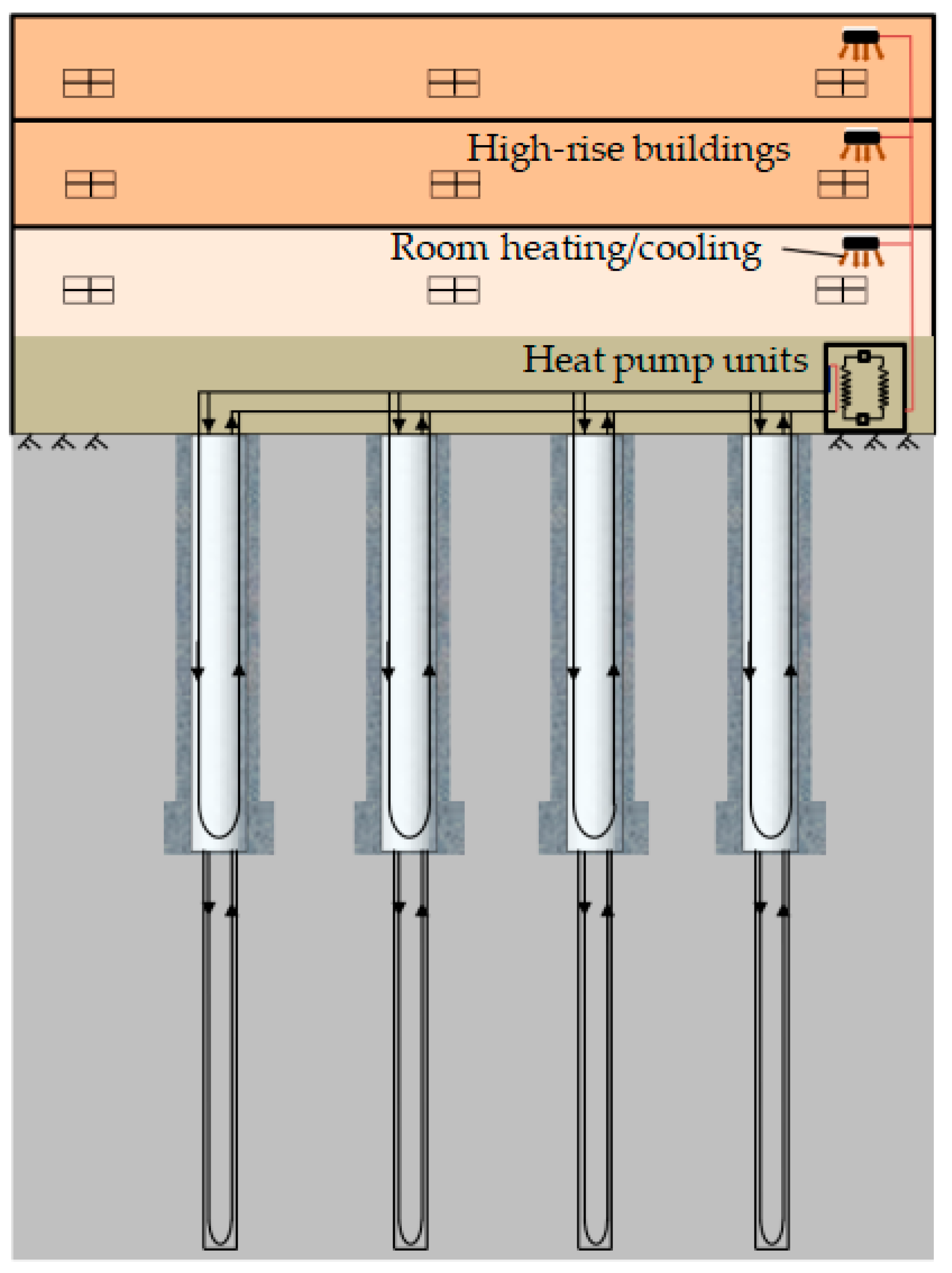


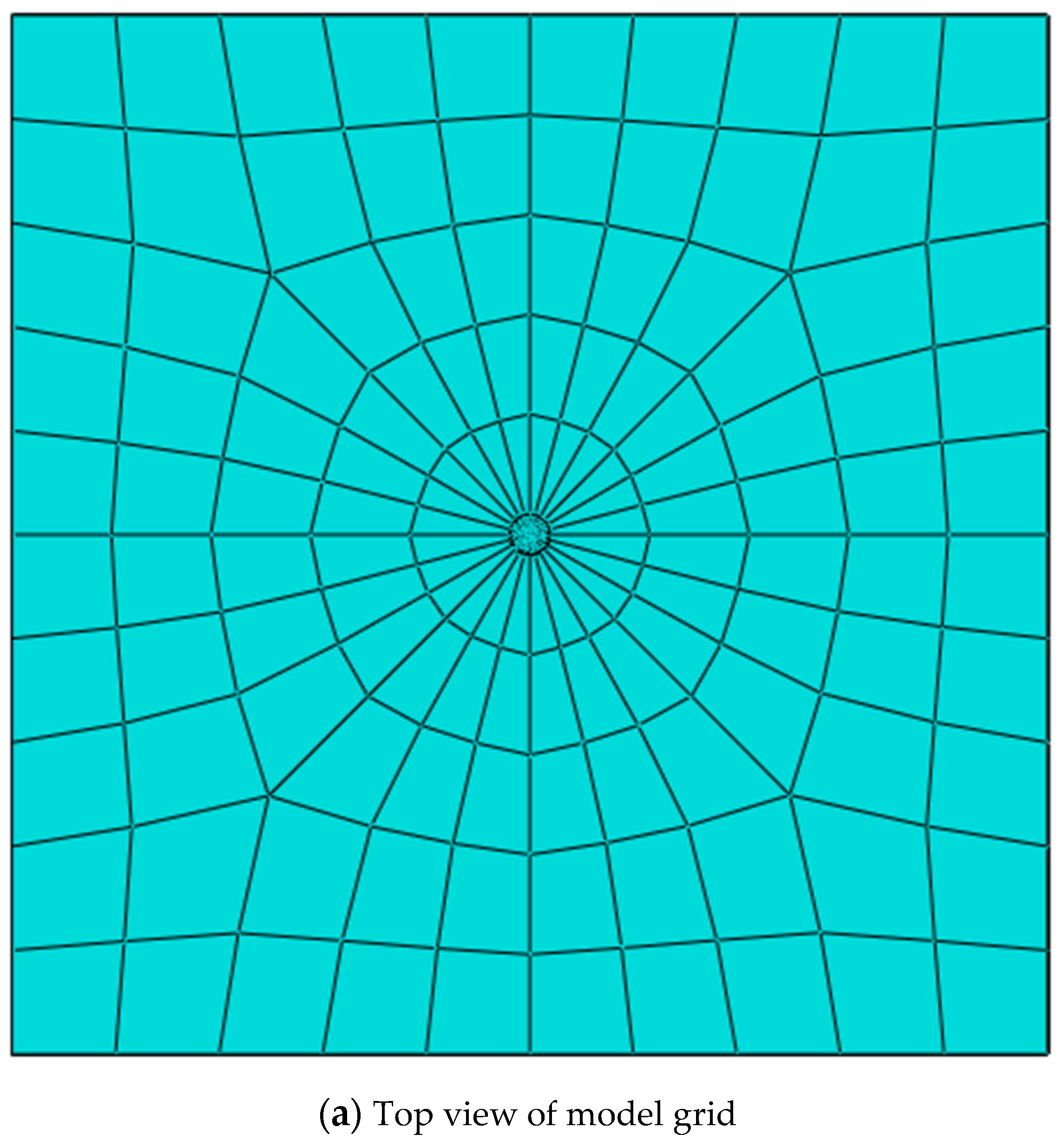


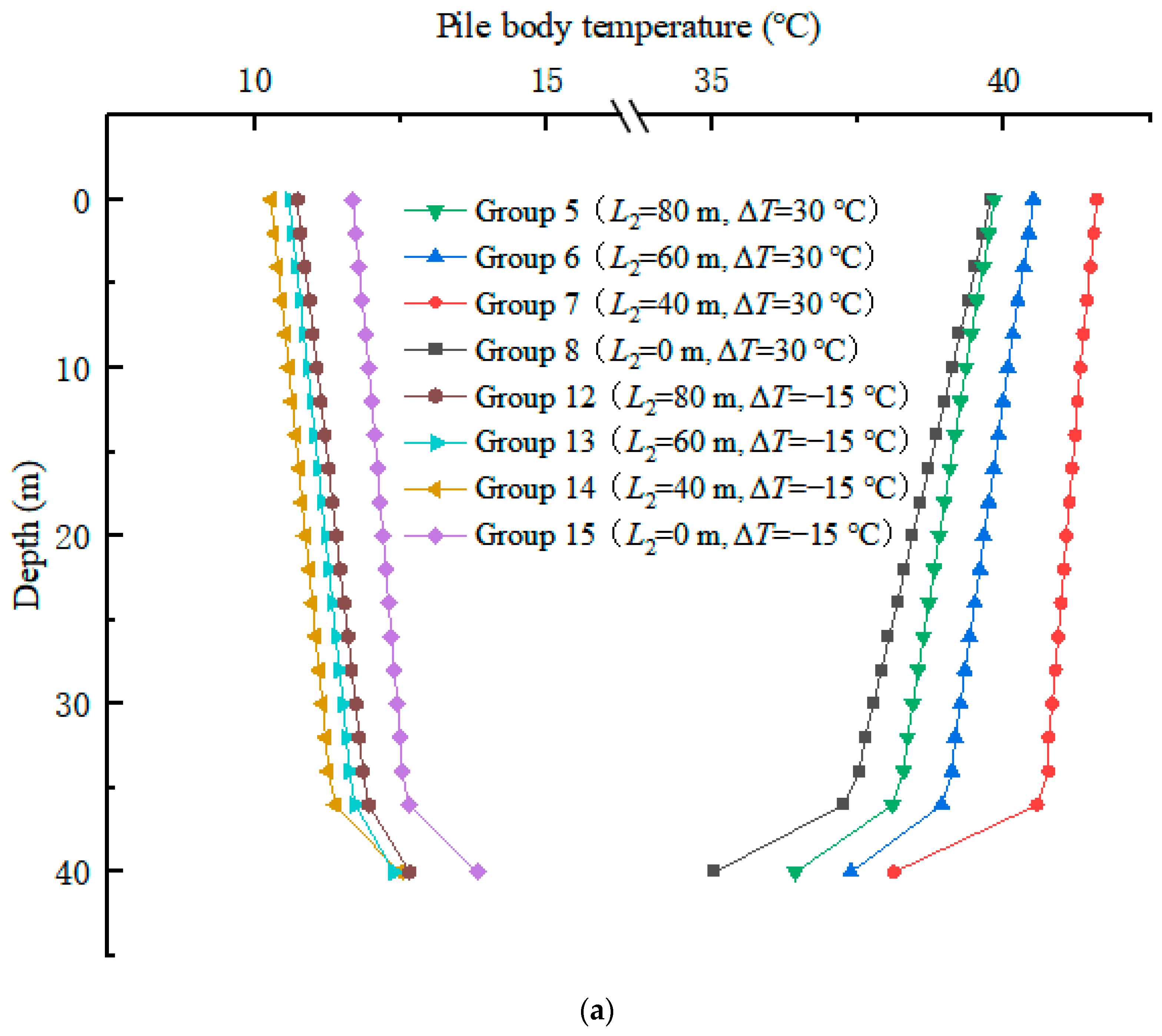
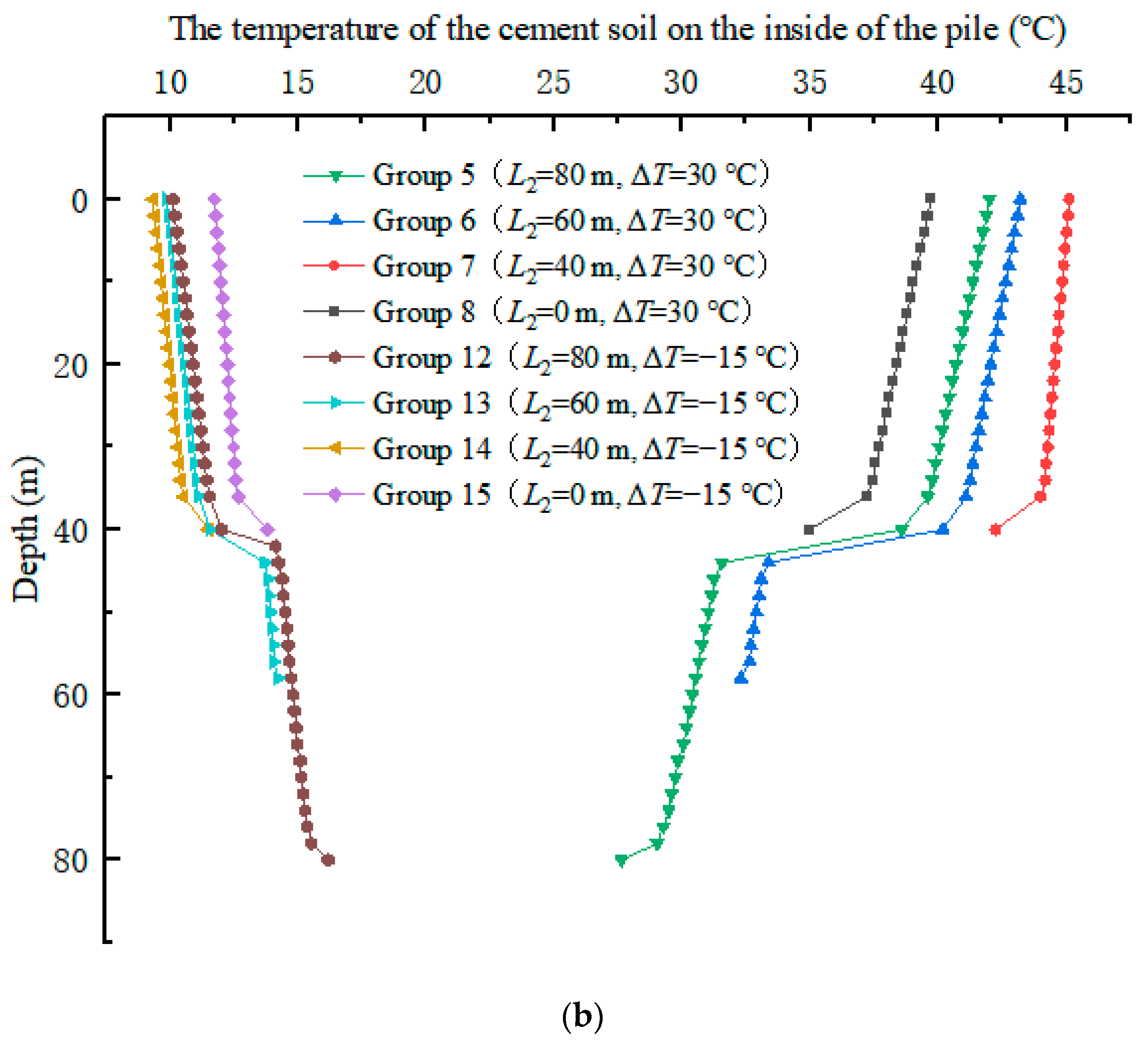


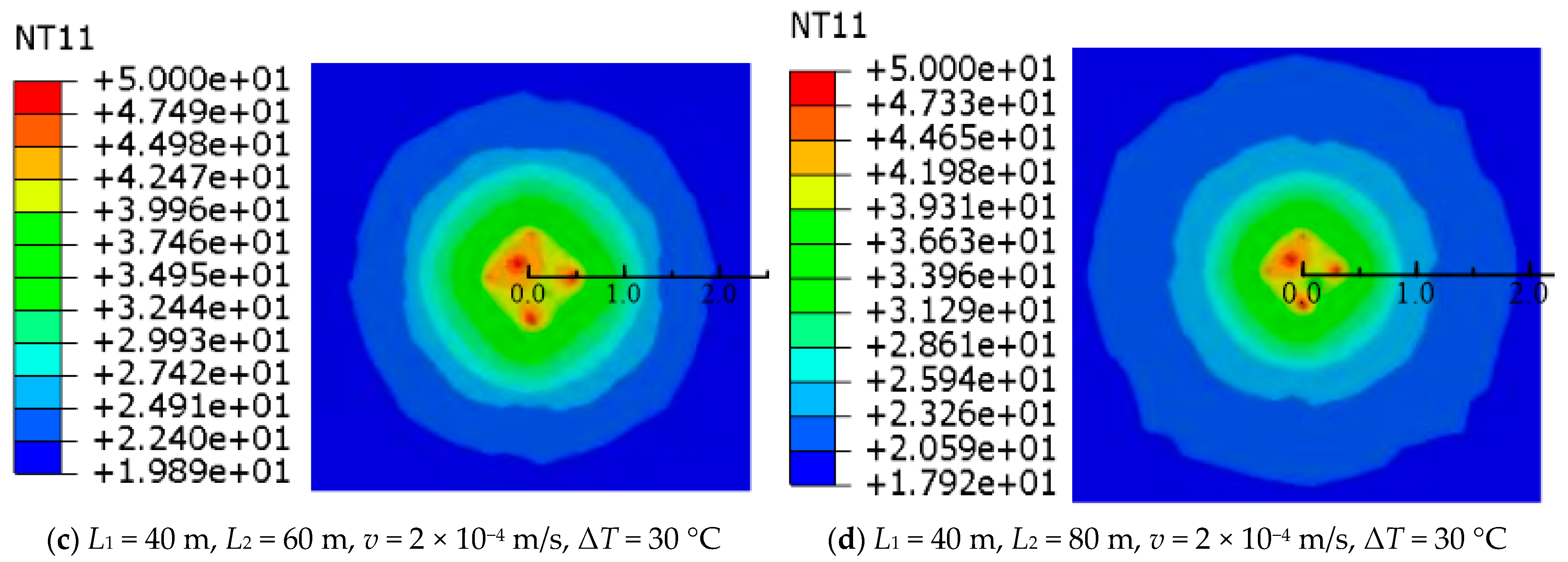


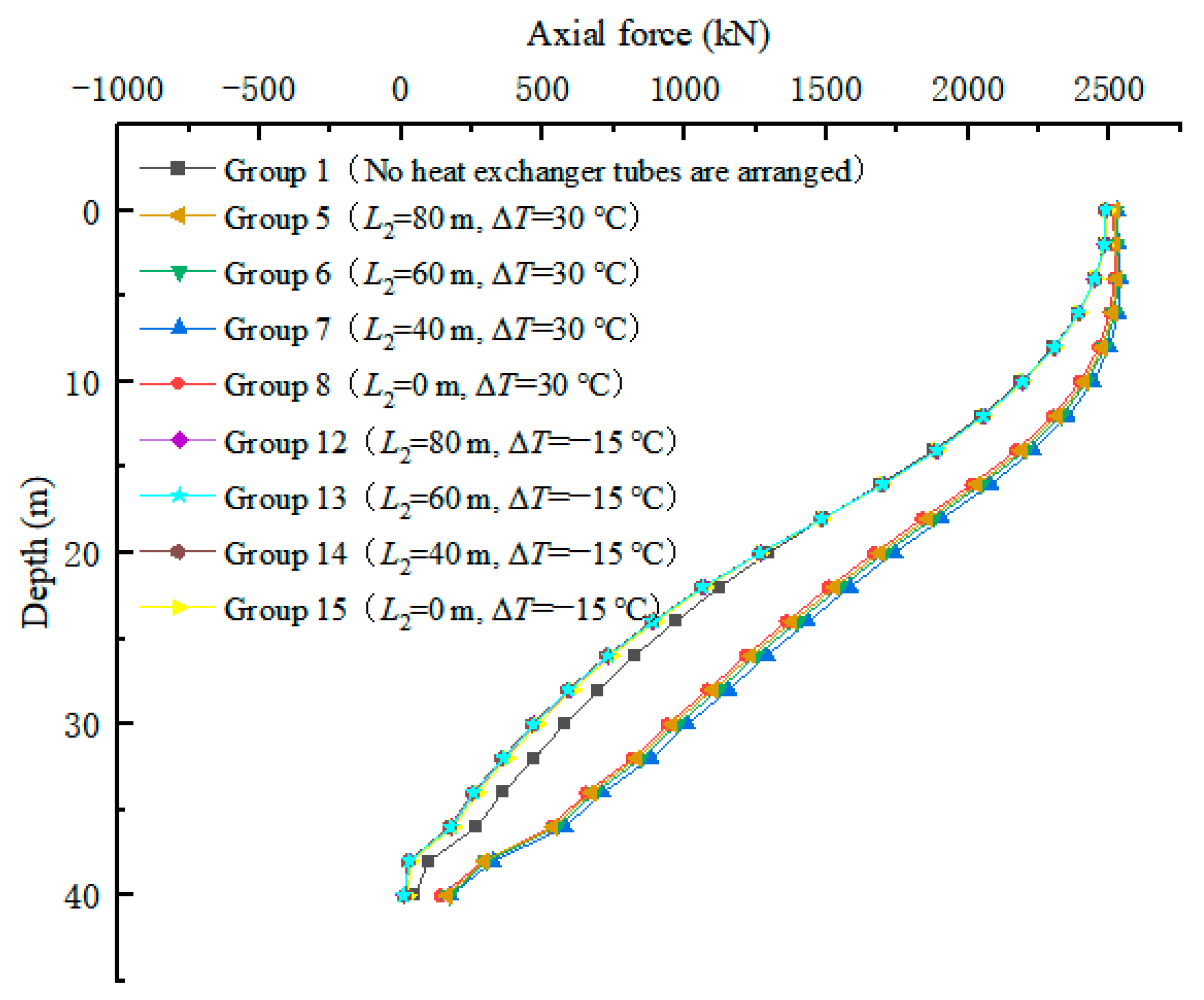

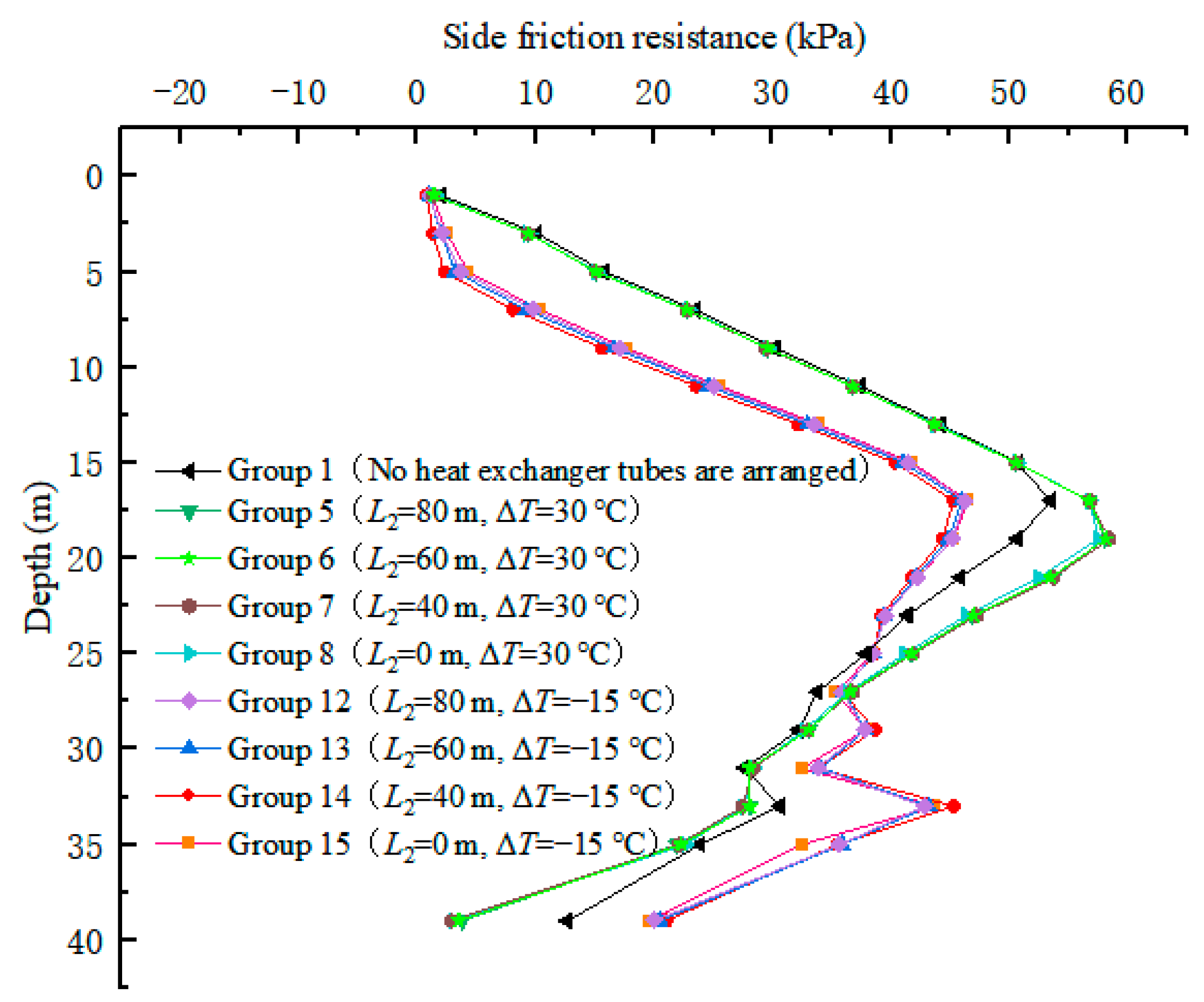

| Material | Thickness (m) | γ (kN/m3) | c (kPa) | φ (°) | µ | E (MPa) | λ (W/mK) | C (J/kgK) | α |
|---|---|---|---|---|---|---|---|---|---|
| Clay | 40 | 19 | 37.8 | 16.9 | 0.35 | 25 | 1.26 | 1670 | 5 × 10−6 |
| Sandy soil | 60 | 19.4 | 42.9 | 17 | 0.3 | 65 | 1.7 | 1620 | 5 × 10−6 |
| Cement soil | / | 20 | 150 | 45 | 0.25 | 180 | 0.96 | 1000 | 7 × 10−6 |
| Precast piles | / | 25 | / | / | 0.2 | 38,000 | 1.74 | 1706 | 1 × 10−5 |
| Heat exchanger tubes | / | 12 | / | / | 0.4 | 2000 | 0.48 | 2300 | / |
| Group | Groundwater Seepage Rate (m/s) | Heat Transfer Fluid Temperature (°C) | Heat Exchanger Tube on the Outside of the Pile (m) | Heat Exchanger Tube on the Inside of the Pile (m) |
|---|---|---|---|---|
| 1 | 2 × 10−4 | / | 0 | 0 |
| 2 | 0 | 50 | 40 | 80 |
| 3 | 2 × 10−6 | 50 | 40 | 80 |
| 4 | 2 × 10−5 | 50 | 40 | 80 |
| 5 | 2 × 10−4 | 50 | 40 | 80 |
| 6 | 2 × 10−4 | 50 | 40 | 60 |
| 7 | 2 × 10−4 | 50 | 40 | 40 |
| 8 | 2 × 10−4 | 50 | 40 | 0 |
| 9 | 0 | 5 | 40 | 80 |
| 10 | 2 × 10−6 | 5 | 40 | 80 |
| 11 | 2 × 10−5 | 5 | 40 | 80 |
| 12 | 2 × 10−4 | 5 | 40 | 80 |
| 13 | 2 × 10−4 | 5 | 40 | 60 |
| 14 | 2 × 10−4 | 5 | 40 | 40 |
| 15 | 2 × 10−4 | 5 | 40 | 0 |
Disclaimer/Publisher’s Note: The statements, opinions and data contained in all publications are solely those of the individual author(s) and contributor(s) and not of MDPI and/or the editor(s). MDPI and/or the editor(s) disclaim responsibility for any injury to people or property resulting from any ideas, methods, instructions or products referred to in the content. |
© 2023 by the authors. Licensee MDPI, Basel, Switzerland. This article is an open access article distributed under the terms and conditions of the Creative Commons Attribution (CC BY) license (https://creativecommons.org/licenses/by/4.0/).
Share and Cite
Chen, S.; Deng, Y.; Niu, S.; Ming, W.; Chen, G.; Zhang, R. Finite Element Analysis of Combined Energy Piles with Long and Short Heat Exchanger Tubes. Appl. Sci. 2023, 13, 12579. https://doi.org/10.3390/app132312579
Chen S, Deng Y, Niu S, Ming W, Chen G, Zhang R. Finite Element Analysis of Combined Energy Piles with Long and Short Heat Exchanger Tubes. Applied Sciences. 2023; 13(23):12579. https://doi.org/10.3390/app132312579
Chicago/Turabian StyleChen, Shuaijiong, Yuebao Deng, Shuai Niu, Wei Ming, Guannian Chen, and Rihong Zhang. 2023. "Finite Element Analysis of Combined Energy Piles with Long and Short Heat Exchanger Tubes" Applied Sciences 13, no. 23: 12579. https://doi.org/10.3390/app132312579
APA StyleChen, S., Deng, Y., Niu, S., Ming, W., Chen, G., & Zhang, R. (2023). Finite Element Analysis of Combined Energy Piles with Long and Short Heat Exchanger Tubes. Applied Sciences, 13(23), 12579. https://doi.org/10.3390/app132312579





